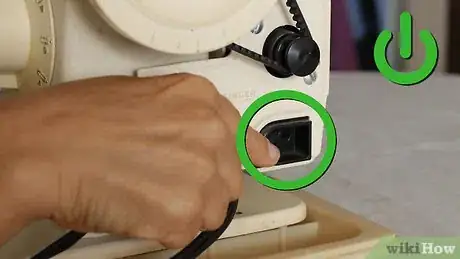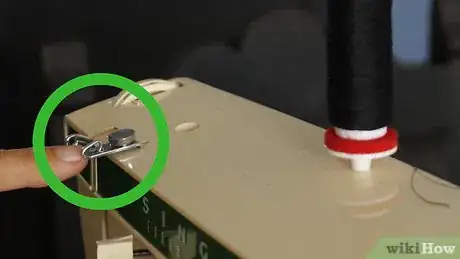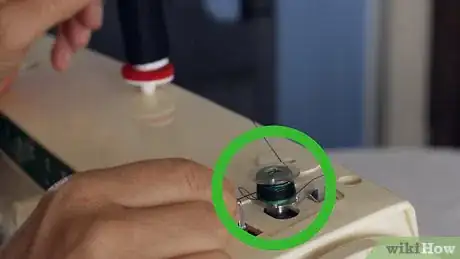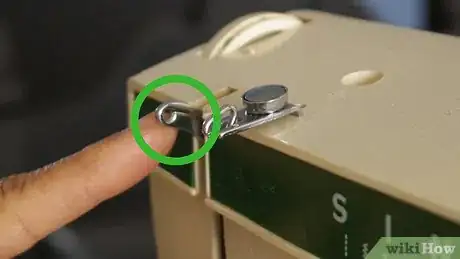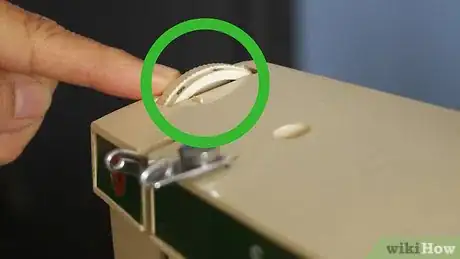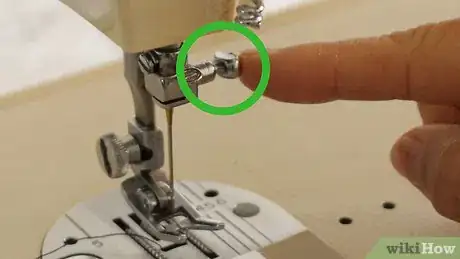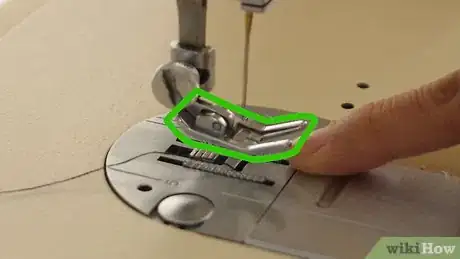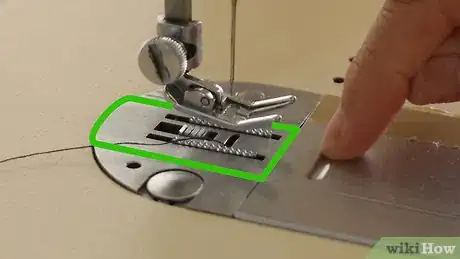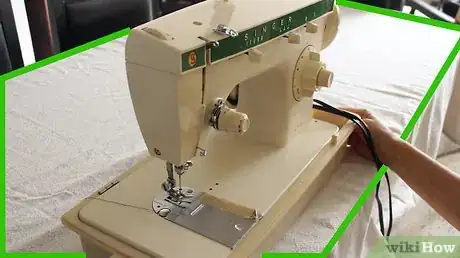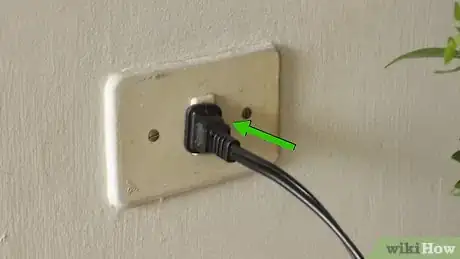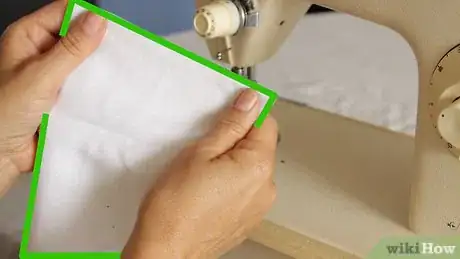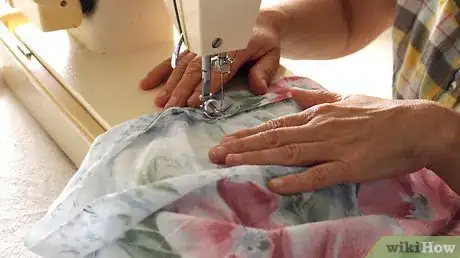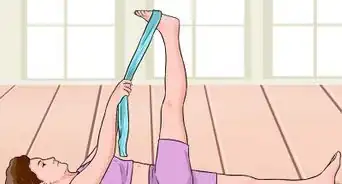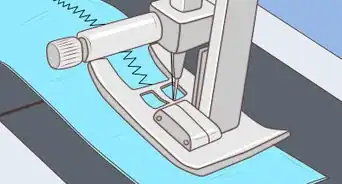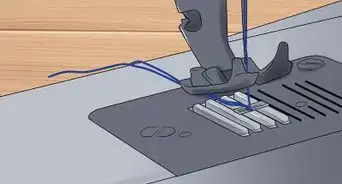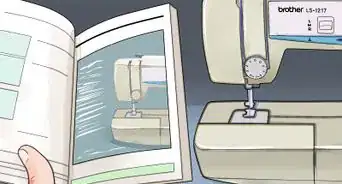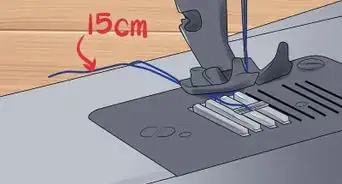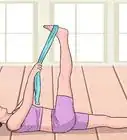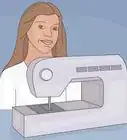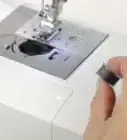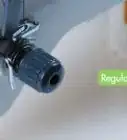This article was co-authored by Daniela Gutierrez-Diaz. Daniela Gutierrez-Diaz is a professional pattern maker and clothing designer at DGpatterns in Vancouver, Canada. With over 5 years of experience, Daniela creates modern and unique silhouettes that are suitable for a busy everyday life. Her blog, On the Cutting Floor, contains sewing tips and PDF sewing patterns for a variety of projects and designs.
There are 9 references cited in this article, which can be found at the bottom of the page.
wikiHow marks an article as reader-approved once it receives enough positive feedback. This article received 18 testimonials and 86% of readers who voted found it helpful, earning it our reader-approved status.
This article has been viewed 1,792,698 times.
Sewing machines can look frighteningly complex to those of us who don't know how to use them. However, don't let the fear of an unknown machine and skill set keep you from creating glorious textile wonders! Use this step-by-step guide through the anatomy, set-up, and use of a sewing machine so that you can begin crafting your own hand-made items.
Things You Should Know
- Familiarize yourself with the machine’s spool pin, threat guide, bobbin-winder, stitch adjustment buttons, tensile dial, presser foot, and other important parts.
- Place the machine flat on a sturdy table and install a needle. Wind and insert the bobbin, then thread the machine and get both threats out.
- Set the machine to a straight stitch at first. Line up the fabric under the needle and lower the presser foot onto the fabric before pressing the foot pedal.
Steps
Learning the Parts of a Sewing Machine
-
1Find the power switch. It may seem silly, but locating the power switch is the most important step! This is located in different places depending on the sewing machine you have, but is normally on the right side of the body.
-
2Locate the spool pin. This is a small plastic or metal pin that sticks out of the top of the sewing machine, and holds your spool of thread.Advertisement
-
3Look for the thread guide. The thread guide directs thread from the spool on the top of the machine to the bobbin winder. It is a geometric metal piece that sticks out of the top of the sewing machine on the left side.
-
4Find the bobbin-winder. To the right of the spool pin on top of the sewing machine is another smaller plastic or metal pin, next to a small horizontal wheel. This is the bobbin winder and the bobbin winder stopper. These work together (with the spool of thread) to wind thread onto your bobbin prior to starting sewing.
-
5Look for the stitch adjustment buttons. These are in different locations depending on the specific sewing machine you have, but there is typically a small screen next to a few physical buttons on the front side of the sewing machine. These buttons select the type of stitch you create, the length of the stitch, and the direction of the stitch (forward or in reverse). Check the manual for your specific machine to determine the functions for each of the buttons.
-
6Locate the thread take-up lever. When you're ready to thread your sewing machine, you will wind the thread from the spool on top, through the thread guide, and then around the takeup lever. This is the lever (with two cut-in grooves) located on the front left side of the sewing machine. There are typically numbers and arrows printed next to it to clearly direct you the way in which to thread the machine.
-
7Look for the tension dial. The tension dial is a small numbered wheel near the takeup lever. It controls the tension of the thread as you sew; if the tension is too tight, the needle will be pulled to the right. If the tension is too loose, the thread will loop on the bottom of the fabric you are sewing.[1]
-
8Find the needle clamp screw. This is a metal piece that holds the needle in place while sewing. It is located under the arm of the sewing machine, looks similar to a large nail, and sticks out to the right side of the needle.
-
9Look for the presser foot. This is a metal attachment under the needle clamp screw that looks like a small ski. When engaged, this holds the fabric in places and guides it through the sewing machine as you sew.
-
10Find the presser foot lever and practice raising and lowering the presser foot. It will be a lever to the right or back of the needle assembly. To adjust the presser foot, move it all the way down and all the way up.
-
11Look for the needle plate. the needle plate is the silver plate just below the needle. Simple enough, huh?
-
12Find the feed dog. The feed dog (silly name, right?) is a small metal guide under the presser foot on the needle plate that moves the fabric through the machine as you sew. You can find it by looking for the two small metal rows underneath the presser foot.[2]
-
13Locate the bobbin cover and bobbin release. The bobbin is a small spool of thread that is supplied from the bottom of the sewing machine, and supplies thread to the needle for the backing. Under the metal plate where the needle is is the bobbin cover, and next to that there should be a cover release button or pin. You'll use this to put the bobbin in place before sewing.[3]
Setting Up your Sewing Machine
-
1Place the machine on a sturdy table, desk, counter, or sewing cabinet in front of you. Sit in a chair that is a comfortable height for the height of the table. Arrange the machine so that the needle end is on your left and the body of the machine is on the right. You will be checking a couple of things first and getting to know the machine a bit, so don't plug it in just yet.
-
2Install a needle securely. Needles have a flat side, so they can only go one way, usually with the flat side toward the back. There is a groove down one side of the needle, generally opposite the flat side of the shank––this groove must be facing the direction from which the needle is threaded when installing the needle (the thread rides in this groove while going up and down through the fabric.) Insert a needle all the way into the post and tighten the thumbscrew securely.If you are still having trouble, refer to your machines manual.
-
3Wind and insert the bobbin. A machine uses two thread sources, a top thread and a lower thread, stored on a bobbin. To wind the bobbin, place the bobbin spool on the bobbin winder on the top. Follow the guides, and wrap the thread from the thread spool around the guide and to the bobbin.[4] Turn the bobbin winder on, and wait for it to stop automatically when the bobbin is full.
- When the bobbin has been wound, place it in the bobbin cage below the needle on the lower half of the sewing machine. Sometimes the bobbin simply drops in (the bobbin case is built in). In this case it is important to pass the thread through a small notch at the front of the case and then pulled to the left. Leave the end of the thread outside. It will need to be brought up through the hole in the needle plate after you have threaded the top thread.
- Follow the link above for detailed instructions on winding and inserting a bobbin.
-
4Thread the sewing machine. The spool of thread resides on the top of the sewing machine, but must be unwound and attached to the needle. To do this, take the thread and pull it through the thread guide at the top, and then down and around the takeup lever. There should be small numbers and arrows printed on the machine showing the way in which to thread the machine.
- You may also be able to follow the guides printed on your machine.
- Usually, the thread follows this general pattern: "left, down, up, down, into a hook, through the needle." Another way to know how to thread the machine is "Spool pin, tension, take-up lever, needle, using thread guides provided between these parts".[5]
- The needle might be threaded from the left, the right, or from front to back. If it is already threaded, that is a clue to the direction; if not, the last thread guide before the needle, is located nearest to the direction from which you must thread the needle.
-
5Get both threads out. Hold the needle thread taut, and towards you in your left hand. With your right hand, make one complete needle down/up revolution by turning the hand wheel toward you. Now pull up on the needle thread that you are still holding with your left hand. The bobbin thread was caught when the threaded needle went down and up and is now looped over the needle thread. Pull on one side of the loop to bring up the bobbin thread tail, or just release the needle thread and pass a pair of scissors between the presser foot and plate to pull the looped bobbin thread out. You should now have the ends of two threads, one from the needle and one coming up from below from the bobbin.
-
6Plug the machine in and turn it on. Many sewing machines have a built-in light, which is often a good way to tell whether there is power to the machine. The power switch will usually be on the right side or back of the machine, if there is one. Some machines don't have a separate switch, in which case they're turned on as soon as they're plugged in.[6]
- Plug the pedal into the machine, too. Place the pedal in a comfortable spot under your feet.
Sewing With Your Machine
-
1Select a straight stitch and a medium stitch length. Consult your manual for how to do this on your machine. On this machine, stitches are set by rotating the lower knob on the right side of the machine until it clicks into place. Always set the stitch with the needle up and out of the fabric, since it may move the needle.
- A straight stitch is used to sew most seams. The next most common stitch is the zigzag, usually used to prevent edges from fraying.
-
2Practice on some scrap material. Choose a simple, woven material, not a knit one, for your first sewing experience. Don't use a very heavy fabric for your first attempts at machine sewing. Denim and flannel can be hard to sew because they are too thick when several layers are piled together.
-
3Line up the fabric under the needle. Sew with the bulk of the material to the left of the machine; crowding the bulk on the right side can cause messy stitching.
-
4Lower the presser foot onto the fabric. There is a lever behind or to the side of the needle assembly that raises or lowers the presser foot.
- If you give the fabric a gentle tug while the presser foot down, you'll feel that the machine grips it pretty firmly. While you sew, the machine uses a feed dog under the presser foot to advance the fabric at the correct speed. There's no need to pull the fabric through the machine; in fact, pulling can bend the needle or damage your project. You can adjust the speed and the stitch length on the machine.
-
5Hold the loose ends of both threads. For the first few stitches, you'll need to hold these ends to keep them from retreating into the fabric. After you've stitched for a short distance, you can let go and use both hands to control the fabric and the machine.
-
6Press the foot pedal. The foot pedal is your speed control. Just like the gas pedal in a car, the harder you push it, the faster you will go. Push it slowly at first, just enough to get the machine going.
- Your machine may have a knee bar rather than a foot pedal. If that's the case, use your knee to push it to the right.
- You can use the balance wheel on the top, right side of the machine to get the machine spinning or to move the needle by hand.
- The machine will advance the fabric automatically away from you. You can "steer" the fabric in a straight line or a curve by guiding it through the machine with your hands. Practice sewing in a straight line and try sewing some curves. The only difference is how you guide the fabric.
- Do not force the material or pull the material while it is going under the needle. This can cause the material to stretch or the needle to break, or the stitches to clog up in the bobbin. If you feel like the fabric is not moving fast enough, press the foot pedal harder, adjust the stitch length, or (if you must) buy a faster machine.
-
7Find the reverse button or lever and try it. It reverses the direction that the machine feeds, so that the fabric travels toward you as the machine sews. Often, this button or lever is spring-loaded, so you must hold it down to sew in reverse.
- At the end of a seam, sew a few stitches in reverse back over the last few stitches you just made. This finishes the seam and helps keep it from pulling out.[7]
-
8Use the hand wheel to move the needle to its highest position. Then, raise the presser foot. The fabric should pull out easily. If the thread pulls back when you try to remove the fabric, check the needle position.
-
9Cut the thread. On many machines, there is a small notch on the back of the post that holds the presser foot. You can hold both ends of the thread and draw it down over this notch to cut the thread. If you don't have such a notch or you would like a cleaner cut, use scissors to trim the thread. Leave a tail extending from the machine for your next seam.
-
10Practice sewing a seam. Pin two pieces of fabric, right sides together, near the edge. The seam will go 1/2 inch (1.3cm) to 5/8 inch (1.5cm) from the edge. You can sew a single layer of fabric (and might do so to stop an edge from fraying, say), but since the goal of most machine sewing is to join two pieces of fabric, you should get used to sewing with a couple of layers and pins.
- Fabric is pinned right sides together so that the seam allowance will end up on the inside. The "right" side is whichever side of the fabric you will want on the outside when the piece is done. On printed fabric, it is generally the side with brighter colors. Solids may not have an obvious right side.
- Place the pins perpendicular to the line where the seam will go. You can sew right over straight pins, and still remove them later with no damage to the machine, the fabric, or the pins. It is safer to remove pins just before stitching reaches them, as accidentally striking a pin will break, or at least dull the needle. Avoid sewing over the heads of the pins, however.
- While you're looking at the fabric, notice which way the fabric itself goes. Seams may go any direction, but most sewing projects are cut so that the main seams go parallel with the lines of the weave. Also note the direction of the print if your fabric has one, and arrange it so it will be "right side up" such as with a floral or animal print or so that stripes or other patterns run a certain direction.
-
11Move to another part of the fabric. Use the hand wheel at the top of the right side of the machine to move the needle to the top of its travel before starting a seam and again to remove the fabric from the machine at the end of a seam. This lifts the needle, and allows you to move to another area of the fabric you're working on.
- If the needle is not at the top of its travel, the thread may not move when you pull on the ends.
- Look for lines on your sewing machine indicating seam allowance. This is the "normal" space between the edge of the fabric and the stitching line. Generally, you should use the line at 5/8" (1.5cm) or 1/2" (1.3cm). Use a ruler measure on either side of the needle. This should already be marked on your machine's "throat plate" (the flat metal piece that the needle goes through). If not, mark it yourself with masking tape.
-
12Learn to sew a sharp corner. Where you want to turn the corner, lower the needle all the way into the fabric. You can use the hand wheel to lower the needle. Raise the presser foot. Leave the needle down, in the fabric. Then, Rotate the fabric to the new position, leaving the needle in it. Finally, lower the presser foot with the fabric in the new position and resume sewing.
-
13Try a simple project. When you have made an assortment of test seams and start to feel comfortable with the basics, try sewing a pillow, pillowcase, or cloth gift bag.EXPERT TIPDaniela Gutierrez-Diaz is a professional pattern maker and clothing designer at DGpatterns in Vancouver, Canada. With over 5 years of experience, Daniela creates modern and unique silhouettes that are suitable for a busy everyday life. Her blog, On the Cutting Floor, contains sewing tips and PDF sewing patterns for a variety of projects and designs.Clothing Designer & Sewing Blogger
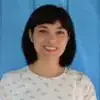
 Daniela Gutierrez-Diaz
Daniela Gutierrez-Diaz
Clothing Designer & Sewing BloggerKeep your sewing machine clean. Brush out any linen that's blocking the bobbin and apply oil to the shuttle hook. This should keep it running well and quietly!
Community Q&A
-
QuestionThe pressure foot has dropped. How do I reattach the foot?
 Community AnswerSome feet are attached by simply hooking it back onto the arm. Others have small levers behind the spot where the foot attaches. Those will allow you to hook the foot back on. It really depends on the machine, but those will be the two most common methods.
Community AnswerSome feet are attached by simply hooking it back onto the arm. Others have small levers behind the spot where the foot attaches. Those will allow you to hook the foot back on. It really depends on the machine, but those will be the two most common methods. -
QuestionHow do you know if you're an expert on sewing?
 Community AnswerYou'll know when your finish product(s) comes out nice and neat (thread is in a straight line, corners are nice and neat etc.).
Community AnswerYou'll know when your finish product(s) comes out nice and neat (thread is in a straight line, corners are nice and neat etc.). -
QuestionShould I learn how to sew before I get a sewing machine?
 Community AnswerNo, you can also learn how to use a sewing machine through online videos after you buy the machine. Most machines come with an instruction manual on how to use them or even an instruction DVD for the specific model.
Community AnswerNo, you can also learn how to use a sewing machine through online videos after you buy the machine. Most machines come with an instruction manual on how to use them or even an instruction DVD for the specific model.
Warnings
- Keep your fingers clear of the needle. Unplug the machine to thread it and don't put your fingers underneath while sewing.⧼thumbs_response⧽
- Don't force the machine. If the needle does not seem to want to go through the fabric, you may be sewing too much fabric.⧼thumbs_response⧽
- Do not sew over the pins holding your fabric, it weakens the seam and can break the needle.⧼thumbs_response⧽
Things You'll Need
- Sewing machine
- Extra needles; but choose the right ones for the fabric
- Straight pins; a pincushion or magnet will help keep them from getting lost
- Fabric
- A sturdy table, counter, or work surface
- Thread
- Bobbins that fit your machine
- Seam ripper (probably not needed for sample pieces but indispensable when sewing)
- Sewing scissors
References
- ↑ https://www.threadsmagazine.com/2008/11/02/understanding-thread-tension
- ↑ https://www.youtube.com/watch?v=SsEp0XfUEf8
- ↑ https://sew4home.com/out-of-the-box-basics-id-the-main-parts-of-a-sewing-machine/
- ↑ https://crazylittleprojects.com/how-to-use-sewing-machine/
- ↑ https://www.mybluprint.com/article/consider-this-your-go-to-guide-for-threading-a-sewing-machine
- ↑ http://thediydreamer.com/sewing/sewing-101-guide-for-beginners-like-me/
- ↑ https://makeit-loveit.com/sewing-machine-practice-end-back-stitch
- ↑ https://www.sewingpartsonline.com/blog/ultimate-thread-reference-guide/
- Videos provided by CRAFTYAMY
About This Article
Before you use a sewing machine, install a needle securely into the post and tighten the thumbscrew, then use the guides on the machine to show you how to guide the thread around the bobbin and through the needle. When the machine is threaded, plug in the machine and guide your fabric under the needle, with the bulk of the material to the left of the machine. Lower the presser foot onto the fabric, hold both ends of the thread, and gently push the foot pedal to start feeding the fabric through the sewing machine. If you want to learn simple projects to try once you learn how to use your machine, keep reading!
